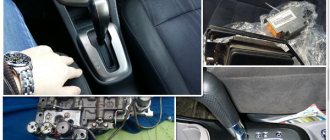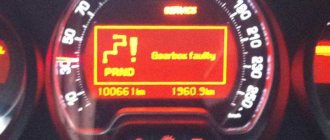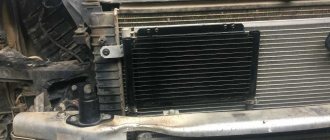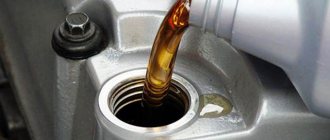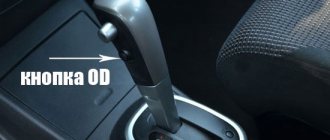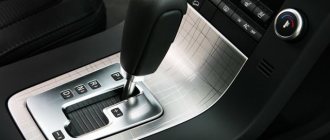Symptoms of automatic transmission slipping
We can talk about slipping if, while driving, the engine starts to idle while shifting to a higher gear. If you do not pay attention to this, the problem will worsen and the car will begin to slip more and more often. After some time, slipping will occur already during the start and when switching to higher and lower gears. It looks as if the engine is greatly increasing its speed, but the speed limit does not change.
When slipping, shocks are also possible, the engine begins to run jerkily. Other signs of this unpleasant phenomenon are deterioration in acceleration dynamics and poor response of the car to pressing the speed pedal.
When slipping, increased speed may be observed - this means that the speed does not correspond to the speed limit. For example, you have established that at a speed of 120 km/h you have 3,000 rpm. But one day you notice that at the same speed the tachometer shows about 4,000 rpm. And all this while driving on a flat road and with an unloaded car. In especially severe cases, slipping is accompanied by noise, knocking and other unpleasant sounds. Vibration may occur.
Torque converter slippage: why it happens and the main symptoms
So, the torque converter or automatic transmission fluid coupling is the clutch of an automatic transmission. Moreover, this device is very different from the usual mechanical clutch, which is installed on manual transmissions and a large number of robotic gearboxes with one clutch.
To make it clear, the principle of operation of a torque converter is that the torque converter housing is attached to the engine flywheel through a special adapter plate. The housing rotates together with the flywheel. By the way, the gas turbine engine itself is sealed; inside the automatic transmission “donut” housing there is ATF transmission fluid.
So, the flywheel spins a special pump wheel located inside the torque converter. As a result, the oil passes through the torque converter reactor, then enters the turbine (turbine wheel), causing it to rotate. The turbine transmits energy to the input shaft of the automatic transmission. As you can see, the torque converter plays the role of a clutch between the engine and the gearbox, but there is no rigid connection, since the energy is transmitted through the oil.
This solution makes it possible not only to transmit, but also to additionally convert torque from the engine, which allows optimizing effort, achieving soft shifting of automatic transmission gears, reducing vibrations, shock loads, etc. Also in modern gas turbine engines, torque converter locking is actively used.
Blocking the gas turbine engine is necessary to minimize losses that inevitably arise due to the lack of a rigid connection and transmission of torque through the liquid inside the torque converter. Also, the fact that the working fluid (ATF oil) gets very hot leads to a decrease in efficiency. In a nutshell, in certain modes, a mechanical lock is activated inside the gas turbine engine, which in its principle resembles a mechanical clutch.
Article on the topic: The smell of gasoline when starting the engine: the main reasons
Locking the donut allows torque to be transmitted from the engine directly rather than through liquid, which provides increased efficiency, better fuel economy, more intense vehicle acceleration, etc.
- As you can see, the structure of this element is quite complex, and the gas turbine engine also operates under load. It is quite obvious that breakdowns and premature wear often occur. Often, the first signs of a torque converter malfunction look like the car loses dynamics, responds worse to pressing the gas pedal, fuel consumption increases, etc.
An early sign of problems with the gas turbine engine is when the engine speed is slightly increased while driving, that is, for example, if normally in third gear and a speed of 60 km/h it was 2500 or 3000 rpm when driving on a flat road, then it became 3500 or more when driving in exactly the same conditions at the same speed (third gear, flat road, no additional load, etc.).
Also among the initial signs can be identified torque converter slippage (torque converter slippage). If the torque converter slips or slips, this manifests itself in such a way that, for example, when driving in a particular gear and accelerating in it, the engine speed does not increase smoothly, but increases sharply (jumps by 500-600 rpm and higher).
- More serious symptoms are that, in combination with the symptoms described above, when modes D or R are turned on, a hum or howl appears in the box area, and the noise disappears in mode N or P, and also intensifies with increasing engine speed while the car is moving. The driver may also notice that the gearbox shifts gears “hardly”, there are noticeable shocks, vibration has appeared, the engine speed fluctuates greatly when driving, etc.
If, for example, a car with an automatic transmission begins to accelerate poorly, the dynamics are lost and the gearbox is noisy, a common cause is a malfunction of the reactor overrunning clutch inside the gas turbine engine. You also need to pay attention to the symptom when, when you turn on R or D, the car does not move, and the driver presses on the gas and the engine speed clearly increases, but the engine turns a little “heavier” than when pressing the gas in neutral gear N.
In this case, there is a high probability that the torque converter turbine splines have been cut off. If the engine stalls when you turn on D on the automatic transmission or the engine speed drops or jumps, the problem may be related to the torque converter blocking. This malfunction on many cars is diagnosed by connecting a scanner.
If an error of the type “torque converter lock-up clutch, no torque transmission” is detected, this indicates that the torque converter is slipping. The reasons may be different, although often the culprit is the gas turbine engine blocking valve (solenoid), which “sticks” or does not work completely. In any case, such a malfunction leads to the fact that the locking does not work, torque is not transmitted directly, losses occur in the gas turbine engine, acceleration dynamics drop, etc.
Article on the topic: Do-it-yourself cleaning of the car air conditioner
Automatic transmission slips: reasons
When the automatic transmission slips, you need to check the transmission oil. Pay attention to its level - it must correspond to the norm. If necessary, you need to change the oil or add it.
Sometimes more serious problems arise:
- Destruction of friction clutches, which are coupling elements (slippage begins when the engine is cold).
- The solenoids have become unusable (this problem manifests itself “when hot”).
- The hydraulic system has failed (this is a consequence of contamination of the oil pump channels).
- Air filter malfunction (the problem appears when the engine starts).
Next, we will tell you what a driver needs to do when dealing with various symptoms of slipping.
Hot
If the oil is changed, but the problem with slipping remains and the automatic transmission slips when hot, this is evidence of a failure of the solenoid block. Solenoids deteriorate due to the use of low-quality working fluid. You will have to change the electromechanical valves, because the service life of the solenoids is less than the service life of the gearbox. Before replacing the solenoid valves, it is worth measuring the pressure in the transmission system - this will help identify the cause of gearbox failure.
At reduced pressure (this is when the fractional gears slip when “hot”), we can say that the problem lies in the solenoids or in the oil supply pump. After replacing the faulty components, the operation of the automatic transmission is completely restored.
In the cold
If slipping occurs “when cold,” you need to check the friction discs installed on the planetary gearbox. Frictions work in a hard mode, so they wear out quite quickly. The nominal shelf life of friction clutches is 250,000 - 300,000 km. This is approximately the same as the entire automatic transmission, but the clutches can be destroyed long before the car covers the required distance.
When starting off
Slipping occurs when the gas pedal is pressed sharply. In this case, you can hear the sounds of rubbing elements that cannot “grab.” The clutch appears after slightly depressing the gas pedal. But if you do not release the gas, you can hear a strong blow in the area of the automatic transmission. Usually such problems appear in first gear.
A similar malfunction may not occur every time. For example, after leaving the garage there were extraneous sounds in the area of the automatic transmission, but during the second start of the engine there were no more sounds.
Using a special device, we determine the speed of the automatic transmission input shaft - if it corresponds to the speed of the engine crankshaft, the problem is slippage. A zero value indicates a faulty torque converter. One way or another, the automatic transmission needs to be repaired.
In all gears
When switching from one gear to any other, throttle shifting begins to occur. It's similar to pressing the clutch in a manual transmission without reducing the speed. The next gear then, of course, switches on, but only after a pause. If you press the gas pedal sharply, you can expect strong shocks. Slipping occurs precisely at the moment of switching gears - at other times the engine operates as usual.
This can occur due to severe overloads, when the normal speed limit is at least 150 km per hour. The oil burns quickly, and behind it the friction clutches themselves burn. Here there is a clear need to repair the gearbox with mandatory filter replacement.
When shifting from 2nd to 3rd gear
This problem can be solved by replacing the brake band. You will have to dismantle the side cover and check it for wear on the seals.
Hot
After checking the oil level or replacing it, but the automatic transmission does not go hot, most likely the problem lies in a malfunction of the solenoids. Most often they fail due to poor quality transmission fluid. The service life of the solenoids is less than the service life of the entire box, so they will have to be replaced, and with them the electromechanical valves.
To fully diagnose and identify the problem, before replacing the valves, you should measure the pressure in the gearbox system. Reduced pressure will just indicate that the problem that the car drives when cold, but not when hot, lies precisely in the solenoids or in the oil pump. After all faults are eliminated, the operation of the automatic transmission is restored to its previous level.
With this type of work, it is best to change all solenoids, since a single replacement may not give a complete result.
The automatic transmission is slipping: what to do?
It is necessary to diagnose the automatic transmission. Sometimes the cause of slipping is a malfunction of the electronic control unit. The electronics begin to send incorrect signals to the mechanics - this is the cause of the problem. In this case, it is best to completely replace the ECU. The malfunction is detected by computer diagnostics.
How to diagnose
Slipping of an automatic transmission can be determined by noise and incorrect behavior of the car when switching gear modes. It is not recommended to diagnose automatic transmissions in a garage; professional help is needed here.
The most common way to identify faults is computer diagnostics. By the way, it is the most accurate and allows you to localize a fault in a short time based on the error codes issued by the system.
Repairing an automatic transmission is a complicated matter; in most cases it requires dismantling the unit. Only after this the preliminary diagnosis issued by the electronics can be confirmed or refuted.
If the automatic transmission is slipping, this is a serious problem that should be solved by professionals. If the automatic transmission slips, you need to go to a service station to have the unit professionally diagnosed. The automatic transmission is controlled electronically, so standard diagnostic methods are unlikely to be effective - you need to have software and special equipment on hand. Sometimes the problem is solved by replacing the oil filter, but in most cases the unit has to be completely disassembled.
Automatic transmission slips | elimination of automatic transmission slippage
|
eliminating slipping of an automatic transmission On average, repairing a torque converter is cheaper than repairing a valve body. Does not switch to another mode It happens that the “automatic” does not allow you to switch the selector to another mode, no matter how hard you try.
What to do about it, you ask. First, stop, call a tow truck and take the car to a service center.
There, experts will examine the automatic transmission and give their verdict.
You may need to replace the rocker. It is found mainly on old-type automatic transmissions, which have a mechanical connection with the selector. Such a breakdown leads to difficulty switching the selector or to its complete blocking.
It all depends on the mechanics of the damage. Repairs can cost different amounts, since in some cars the linkage can be replaced without removing the automatic transmission, while in others it will be necessary to dismantle it.
How does automatic transmission slip occur?
Slippage can manifest itself either as slight slipping when driving a car, or as significant cranking of the engine while idling when switching to higher gears. There can be a lot of reasons for the transmission slipping. The most common and easily eliminated reason is the use of low-quality or old gear oil. In this case, the problem is solved by replacing the filter element and oil in the gearbox. However, this allows you to solve the problem only with minimal slipping of the box. If the problem worsens, a lengthy and labor-intensive repair of the gearbox is necessary. If your automatic transmission slips , for example when it’s cold, this indicates that the clutches are not working properly.
Symptoms of automatic transmission slipping - Video
If the automatic transmission is slipping, there are reasons for that.
Hydraulic unit
In some cases, the cause of automatic transmission slipping is clogged valve body channels, which do not provide high-quality lubrication to the moving elements, which in turn leads to slipping of the clutches. In this case, automatic transmission slipping is eliminated by cleaning the valve body. The valve body channels are cleaned using special compounds or ultrasound. Modern technologies make it possible to effectively clean oil supply channels from scale and old oil. It should be remembered that this work is performed exclusively with the dismantling of the hydraulic unit and takes several days.
Pump and solenoid block
It is necessary to simultaneously change the filter elements and oil in the gearbox while cleaning the valve body. In most cases, when cleaning the valve body, the solenoids are replaced, which also become unusable from the use of old and low-quality oil. The pressure in the lubrication system is measured, which allows you to determine if there are problems with the solenoids. If the pressure is low and the automatic transmission slips when hot , there may be problems with the pump or solenoids. In this case, the failed elements are replaced, which allows the transmission to return to full functionality. If it is necessary to replace solenoids in an automatic transmission, we recommend performing this work with solenoid packs, which will ensure their correct and trouble-free operation for a long time.
Clutches
Simultaneously with assessing the condition of the valve body when the gearbox slips, the clutches are inspected. During operation, clutches can wear out and become unusable. As a rule, after a mileage of 250 - 300 thousand kilometers, the degree of wear is such that the gearbox clutches have to be replaced. This work presents significant difficulties, since it is necessary to remove the gearbox from the car and completely disassemble it. For this work, special equipment is used, which allows not only to correctly perform dismantling work, but also to assess the condition of the moving elements inside the automatic transmission.
Set of new friction discs for automatic transmission
Automatic transmission ECU (Electronic control unit)
In some cases, the cause of gearbox slipping may be improper operation of the transmission control unit. In this case, electronic brains send incorrect signals to mechanical moving elements, which leads to their slipping. In this case, the problem can be solved by replacing the control unit. Note that diagnosing such breakdowns is not difficult. If the control unit fails, this will be immediately displayed during computer diagnostics of the transmission. In this case, the cost of repair depends on the specific car and the specific transmission. It must be remembered that, despite the apparent simplicity of the work, due to the high cost of the failed control unit itself, the total cost of repairs will be quite significant.
Why you can't skid on automatic
Motorists should remember that a car with an automatic transmission requires close attention and knowledge of driving rules, especially in critical situations. If it’s winter outside and you risk getting trapped in the snow, listen to the advice of experts on how to behave in cases of snow jams. To say unequivocally that you cannot slip with an automatic transmission is not entirely true, there is always a way out.
Cooling box
Heat in automatic transmissions is generated by both the friction discs and the torque converter; under heavy loads, overheating is extremely high; for this purpose, cars with automatic transmissions are equipped with a powerful cooling system. The radiator is built into the engine cooling radiator element, or is cooled using a separate air flow.
When slipping for a long time, the temperature of the lubricant of the automatic transmission rises sharply, until it boils. This leads to the destruction of the friction discs, which are forced to work “hard”. And in the worst case, it can lead to transmission failure.
Conclusion 1. It is permissible to slip with an automatic transmission, but not for long and intermittently.
Slipping on a warm car
If you start slipping on a “cold” car, the lubricant will not warm up enough, which will also lead to harsh operation of the gearbox elements and their rapid wear. First turn on the “R” mode and warm up the car for up to a minute. The lubricant will be brought into working condition, after which you can start slipping.
Conclusion 2. Warm up the car before slipping.
Fixing the transfer
During slipping, the torque converter receives the greatest load, which can lead to its being out of working order. At high temperatures, the properties of liquid oil change, the pressure may drop, which can lead to burnout of the friction discs. Try to clearly fix the gear without changing its position during the slipping process. Always change from mode “R” to “D” using the brake pedal.
Conclusion 3. It is strictly forbidden to squeeze the brake and gas together.
Road grip
Frictions wear out under any serious load, be it towing, slipping or high driving speeds. The automatic transmission has a special element - a differential gearbox with a long axis running along its body. If the wheel hits a hard surface, a very strong blow to the axle is possible, which can tear it out with further penetration of the box body.
Conclusion 4. Avoid sudden traction immediately after slipping.
how to use automatic transmission
When not to skid
Do not try to skid on an automatic transmission if your car is one of the old monsters of the last century. Cars with high mileage suffer from severe wear of the torque converter. The transmission cooling radiator becomes clogged over time, which requires immediate replacement of the automatic transmission. If you are the owner of such a car and are not ready to give up your beloved friend, try not to go on long routes in heavy snow drifts.
If your car is “Japanese” or “European” of an old model, it may have a built-in air cooling system for the automatic transmission, while auxiliary external blades are installed on the surface of the torque converter, which circulate air to relieve the temperature. These automatic transmissions can only cool during movement, so slipping on them is contraindicated.
Conclusion 5. Modern car models from Japanese and European manufacturers with automatic transmissions do not suffer from this drawback; they will get you out of the snowdrifts without any problems.
For a true car enthusiast or an experienced professional, there are no insoluble problems on the roads. The main thing is to know your car like your own and listen to the advice of driving sages.
Repair cost
The cost of repairs for a slipping transmission depends on the specific breakdown. In some cases, this problem can be eliminated by replacing the transmission oil and filter elements. In this case, the cost of work with spare parts will not exceed 5,000-10,000 rubles. At the same time, if there are problems with the valve body, clutches or control unit, the cost of repairs can amount to several tens of thousands of rubles. Remember that the exact cause of a breakdown can only be determined by carrying out the most detailed diagnostics. It is after such a diagnosis that an experienced specialist will tell you the amount of repairs and only after that will begin to fix the breakdown.
When planning repair work on the gearbox, it is necessary to remember that the automatic transmission is a complex structural element, the quality of which can only be serviced and repaired by experienced specialists. That is why we do not recommend that you skimp on the quality of repairs and trust garage specialists to fix problems. Only by contacting specialized service centers, you will be able to completely eliminate existing problems in the operation of gearboxes and receive a guarantee for the repairs performed.
An automatic transmission is a complex but quite reliable unit, the average service life of which exceeds 200 thousand kilometers.
But if the automatic transmission breaks down, be prepared to fork out a decent amount. Preventing the occurrence of such troubles is a much simpler task than correcting them. Today we will talk about automatic transmission slipping - a problem that can lead to very serious troubles for the car owner.
It is important not only to know the main manifestations of this malfunction, but also to understand the reasons for their occurrence - this will help to carry out high-quality diagnostics of the transmission, which will prevent its complete failure.
Symptoms of automatic transmission slipping
If 15-20 years ago only top-end trim levels of mid- and luxury-class passenger cars were equipped with an automatic transmission, today an automatic transmission is no longer a sign of a car’s prestige. They are equipped with both SUVs and miniature city cars. We especially love this type of transmission among the female part of the driving community.
The main factor for such popularity is obvious - the ease of driving. However, for various reasons, over time, the ease of gear shifting disappears. One of the manifestations of this problem is slipping - a phenomenon that not only reduces the efficiency of the transmission, but which can lead to more serious and unpredictable consequences.
As you know, the main task of a gearbox, including an automatic one, is to transmit torque from the power unit to the wheels, preferably without noticeable power losses. Automatic transmission is good because it carries out the assigned tasks with virtually no driver participation. Of course, this is achieved by complicating the design. And the more complex the device, the greater the likelihood of failure of one of its many components. This thesis is also true for automatic transmissions. One of the most typical problems that indicate the beginning of trouble is slipping when changing gears.
This is why it is so important to be able to recognize the symptoms of gearbox slippage in the early stages. Let's list them:
- A sharp increase in the number of revolutions of the power unit. This usually happens when the automatic transmission slips - to switch from 3rd gear to 4th, a set of revolutions is required to a level of about 3-3.5 thousand, and only after that the actual switching occurs (that is, we have an imitation of the Overdrive mode).
- Longer coasting of the car. If you notice that after your foot is removed from the accelerator pedal, the car continues to move for some time as if by inertia, without engine braking, this is also one of the signs of automatic transmission slipping.
- Longer downshifts. There is a high probability that a longer shift, for example, from second to first gear, is caused by automatic transmission slipping. In some cases, before the transmission downshifts, the speed of the power unit increases. So a delay when shifting gears is another symptom that the automatic transmission is slipping.
- Another classic sign of such a malfunction is a delay in the acceleration of the car when pressing the accelerator pedal. Sometimes such a delay is accompanied by a drop in engine power.
- You can tell that the automatic transmission is slipping by the color of the transmission oil. Normally, this liquid has a pronounced reddish tint, but when the gears slip, they are destroyed. As a result, the smallest metal particles that get into the oil, oxidize, give it a brown tint.
- The appearance of uncharacteristic sounds in the form of a grinding sound when driving at high speed should also alert you. In the initial stages, grinding is heard mainly during acceleration and braking in high gears, but over time the noise appears with enviable regularity, and its duration increases. In such cases, it is highly not recommended to delay diagnosing the transmission.
- If you start to experience problems when shifting into reverse gear, most likely the automatic transmission is slipping. The manifestation of this symptom is especially typical in cold weather, at subzero temperatures. As a rule, engaging reverse is accompanied by a time delay and does not occur as smoothly as usual.
There is no need to remind you that if any of the listed signs appear, you should think about it, and if they appear in the plural and at the same time, it is better not to operate the car until the causes of slipping are determined and they are eliminated.
How to understand that the automatic transmission is slipping
Slipping of an automatic transmission is a serious malfunction, so the degree of manifestation varies: from the absence of defects to the transformation of the car into a piece of metal. Often the symptoms indicate another breakdown and you need to figure out what to look for. The fact that the automatic transmission is slipping is manifested by the following situations:
- Engine speed increases - an unreasonable increase in speed to 3-3.5 thousand revolutions leads to the gearbox switching to overdrive mode.
- Coasting motion - inertia does not allow the car to stop instantly, even if the gas pedal is not pressed. When the transmission slips, the car coasts longer than it would if it were in full working order.
- Slow downshifting - if, when the engine speed is lowered, the automatic transmission “thinks” for a long time before engaging a lower gear - this is a sign of a slipping transmission. Switching also occurs with increasing speed, when the engine idles for several seconds and the gearbox simply does not have time to pick up the speed.
- Acceleration lags—if the revs rise but the car takes a few seconds to accelerate—this is a major sign of gear slippage.
- Red transmission fluid is an ambiguous sign, but if it is present, it can be considered that the automatic transmission is slipping.
- Strong sounds at speed - an extraneous grinding noise that intensifies during acceleration and braking, can also indicate slipping of the automatic transmission gears.
- Problems with reverse gear - shifting gears in cold weather with a delay is the main sign that the automatic transmission is actually slipping. In this case, switching is carried out with a delay, without the smoothness of the “automatic”.
Based on the above-described series of signs, you can diagnose the situation that the automatic transmission is slipping. Having learned about the diagnosis, you should understand its reasons, which cannot be ignored.
Having seen a symptom indicating that the automatic transmission is slipping, you first need to check the transmission oil. If its level is low or there is no oil at all, you need to top it up or replace it with a new one.
In addition to problems with oil, there are other reasons for unit failure:
- Destruction of coupling elements (clutches).
- Worn solenoids.
- The automatic transmission valve body has finally broken down (it needs to be replaced or completely cleaned).
- Problems with the air filter.
Automatic transmission diagnostics
The initial diagnosis is precisely to identify symptoms indicating transmission slippage. As a rule, you can determine that an automatic transmission is slipping on your own based on the appearance of various noises and unusual behavior of the car when changing gears. Based on the detected symptoms, you should contact a specialist, since independently clarifying the diagnosis will require disassembling the box. If with a manual transmission this is quite acceptable even in a garage, then with an automatic transmission it is not.
The simplest and most accurate way to identify problems is computer diagnostics, which allows you to localize the problem in a matter of minutes based on the received error codes.
In the vast majority of cases, repairs will still require dismantling the automatic transmission, and it is at this stage that the preliminary diagnosis obtained on the basis of computer diagnostics is usually confirmed or refuted. Of course, this work must be performed by qualified specialists. Without the appropriate experience and skills, attempts at self-recovery are doomed to failure in 99% of cases. So clutch slipping is by no means an insignificant problem.
CARS WITH DSG AND CVT
As you understand, you can skid on an automatic transmission without harming the transmission. This may be due to the operating principle of the torque converter. By slipping, the main engine smoothes out shock loads. If the variator design requires the presence of a torque converter, then the car will endure trips on light off-road conditions much more calmly. But at the same time, you can only skid until the main engine is blocked. In general, you need to work with the gas pedal carefully to minimize increased loads on the belt and cones of the variator.
The disadvantage of the DSG device is precisely the absence of a torque converter. Therefore, clutch packs used in “wet” DSGs, as well as clutch discs of “dry” robotic gearboxes, experience increased loads on off-road roads.
Slipping of the drive wheels in snow and mud can have a detrimental effect on the service life of the automatic transmission. Let's figure out whether it's possible to slip on an automatic transmission without harming the transmission. We will definitely consider the features of off-road driving in a car with a torque converter automatic transmission, a CVT and a robotic gearbox (DSG, Power Shift).
Causes of automatic transmission slipping
Like most other malfunctions, automatic transmission gear slippage begins gradually. However, it is also possible to identify this problem in the early stages. For example, due to too reluctant acceleration with the accelerator pedal depressed. As soon as you suspect something is wrong, immediately contact the nearest car service center for diagnostic measures. This will not only allow you to identify the cause of slippage in a timely manner, but also prevent significant costs in the event of a complete failure of the automatic transmission.
Most of the reasons why an automatic transmission slips are the result of improper operation of the automatic transmission. We list the most typical of them:
- a drop in the TM level (this should not be monitored as regularly as the engine oil level, but many car owners completely ignore this responsibility);
- a significant deterioration in the quality of the transmission fluid, which will be evidenced by a change in the color of the oil to dark, identification of mechanical inclusions in it (dust, chips, suspensions), thickening of the TM, and the appearance of the smell of burning oil);
- the friction clutches, which are clutch elements, have begun to deteriorate - in such cases, slippage occurs when the engine is not warmed up;
- electromechanical transmission valves (solenoids) are faulty - this is the reason for the automatic transmission slipping when hot;
- malfunctions of the hydraulic system caused by contamination of the oil channels of the valve body or the oil pump itself;
- significant deterioration of the air filter is manifested by the occurrence of slippage at the beginning of the machine’s movement;
- errors during the operation of the automatic transmission control unit, which usually appear when the selector switches from one mode to another.
Let's look at some of these reasons in more detail.
Hydraulic unit
The hydraulic system is an important component of an automatic transmission, and it is often the main reason why the automatic transmission slips. As a rule, most problems arise due to clogged valve body channels. This leads to disruption of the normal lubrication process of transmission components, which leads to clutch slipping. There is also a solution to the problem - high-quality cleaning of the oil channels, as well as the replacement of the air filter. The preferred way to perform such work is in a car service center equipped with appropriate specialized equipment. However, recently alternative methods of treating the hydraulic system have been gaining popularity. For example, using special cleaning compounds or using ultrasound. In short, today specialists have at their disposal quite effective technologies that allow them to completely get rid of any contamination of the valve body channels. But in any case, this activity is carried out with the dismantling of the hydraulic system, and this is a very labor-intensive operation that will take at least two days.
Jerks and jerks when turning on the automatic transmission - causes and solutions
Any owner of a car equipped with an automatic transmission sooner or later faces a problem such as jerking and jolting of the automatic transmission that occurs when changing gears. This is an alarm bell, symbolizing a breakdown or the prerequisites for its occurrence. But in some cases, everything is not so scary, and the solution is elementary and can be eliminated “at once.” Let's look at the main causes of jerks when switching.
Three reasons why automatic transmission jerks when switching
- Insufficient fluid level in transmission
Hydraulics are the working tool of the box. Sometimes there is too little fluid to ensure smooth operation. Shocks occur when the automatic transmission is turned on. The driver may simply forget to add oil, or it may be lost due to leaks. The way to fix the problem is obvious - add fluid to the level.
- Dirty transmission oil
This reason can be called the most common. Saving on replacing automatic transmission fluid leads to its saturation over time with foreign impurities, products of the operation of automatic transmission elements, which leads to a deterioration in the physical properties of the oil and insufficient hydraulic forces of the system. To avoid shocks when switching the automatic transmission, the advice is simple - do not violate the regulatory deadlines and change the oil on time. Driving in the cold season is especially dangerous, since the gearbox is overloaded, which naturally shortens its service life.
Used oil in automatic transmission
- Insufficient heating of the transmission fluid
This is again about driving in the cold season. Of course, while driving, the temperature returns to normal, and the shocks in the automatic transmission disappear. But overuse of starting on a cold car leads to wear of components, including the gearbox. It’s better to spend a couple of minutes to adjust the temperature to start moving.
So, now we know why jerks occur when shifting automatic transmission gears. And if everything is in order with your transmission fluid, its volume is at the required level, the car is warmed up, but the automatic transmission jerks have not disappeared, it is worth going to a service center for diagnostics.
-Any questions?
-Something is not clear?
Ask us a question!
Comments: (0)
We recommend that you read:
akpphelp.ru
Automatic transmission ECU
If eliminating all of the above reasons does not solve the problem, the only thing left to blame is malfunctions in the operation of the control electronic unit. Incorrect functioning of the transmission ECU, it turns out, can also affect the operation of individual elements of the gearbox. What to do if the automatic transmission is slipping precisely because of a faulty electronic unit? There are cases when the problem was fixed by flashing it, but most often the ECU has to be replaced with a new unit. It is not difficult to diagnose such a malfunction using an on-board computer, but both diagnosing and replacing the ECU is a procedure that requires the appropriate knowledge and equipment, so you cannot do it yourself. Be prepared for the fact that the cost of this operation specifically for your automatic transmission will not coincide with the market average. This is quite acceptable, since it depends on the design of the box, and it is different for all major manufacturers.
As you can see, independent repair of an automatic transmission is not recommended, even if at first glance it seems that no difficulties should arise. If manual transmissions are designed in principle the same, the differences are mainly only in geometry, then with automatic transmissions the situation is completely different. The slightest mistake during installation - and the chance of permanently damaging the automatic transmission will rapidly increase, and this is one of the most expensive (after the engine) components of a modern car.
Brief summary
So, if we find out that deviations in the behavior of the car are associated with slipping of the automatic transmission, you should immediately go to a trusted service station to diagnose your gearbox.
It is diagnostics that allows you to clarify the diagnosis and begin troubleshooting, knowing what exactly will have to be changed. Since the operation of the automatic transmission is controlled by its own electronic unit, diagnostics cannot be performed using standard means - you need to have the appropriate equipment and software.
Sometimes this procedure does not reveal problems, and after replacing the TM and oil filter, the operation of the transmission returns to normal. But if there are symptoms of gear wear, then in most cases you have to solve the problem by completely disassembling the unit. In particular, this cannot be avoided if the valve body is faulty or if the friction rings are faulty.
It is impossible to estimate the budget for repair work in advance, since everything depends on the specific malfunction, and several of them may be discovered during the repair of the box.
Don’t be surprised if it turns out that even the operation of changing transmission oil will cost much more than when changing the oil in the power unit - the complexity of this operation is corresponding, which has a decisive influence on pricing.
The appearance of slipping symptoms indicates that problems already exist, and repairs most likely cannot be avoided. But if you strictly adhere to the automaker’s recommendations regarding the operation and maintenance of an automatic transmission, then you can be sure that the gearbox will serve you no less than the stated period. This means that you will be able to do without expensive repairs, which are unlikely to be carried out on your own.
Let's sum it up
If slipping, jolting or jerking in the automatic transmission begins to appear when the car is moving, you need to contact a service station for high-quality and accurate diagnostics.
In the first case, the nature of the breakdown is determined based on the readings of diagnostic instruments; it is often possible to normalize the operation of the box by simply changing the automatic transmission oil and filter.
Accordingly, the cost of the repairs performed will depend on the specific breakdown of the automatic transmission and the total scope of work. It is important to remember that even a simple change of oil and oil filter in a machine is a rather labor-intensive and costly procedure. For this reason, you need to clarify in advance how much it costs to change the oil in an automatic transmission.
Finally, we note that proper operation of a vehicle with an automatic transmission and its timely maintenance will extend the service life of the unit, which eliminates premature and expensive repairs of the vehicle’s automatic transmission.
Checking the oil level in an automatic transmission: how to check the ATF level. What else to pay attention to: color, smell, ATP contamination, etc.
Automatic transmission solenoid: design of solenoids, operating principle. Frequent malfunctions and breakdowns of solenoid valves, diagnostics, repair and replacement.
Why the automatic transmission kicks, the automatic transmission jerks when changing gears, jerks, jerks and impacts occur in the automatic transmission: the main reasons.
Is it possible to tow a car with an automatic transmission: basic rules and recommendations. What you need to consider if a car with an automatic transmission is towing another car.
How to service an automatic transmission: changing the automatic transmission oil and oil filter, the cost of changing the oil in an automatic transmission. Methods for replacing ATF, recommendations.
Automatic transmission valve plate (valve unit): design of the valve body, purpose, principle of operation. Valve unit malfunctions, causes of breakdowns, diagnostics and repair.
